Written by Mary Roduner, former SDSU Extension Consumer Horticulture Field Specialist.
This has been a hard garden year so far. First we had a long winter and late cool spring and now much of the state is too wet and cold or has flooded areas. Wet cool soils are prime conditions for many plant diseases to thrive.
Cool, wet conditions promote fungal growth. Many types of fungal diseases require wet weather for the spores to germinate and survive. Dry soil and/or low humidity inhibit spore germination, reducing the chance of fungal diseases spreading. Monitoring the garden closely will let you find these problems quickly and you can begin to treat the plants before the problems become serious or fatal.
The following are some of the most common cool, wet weather problems.
Nitrogen Deficiency
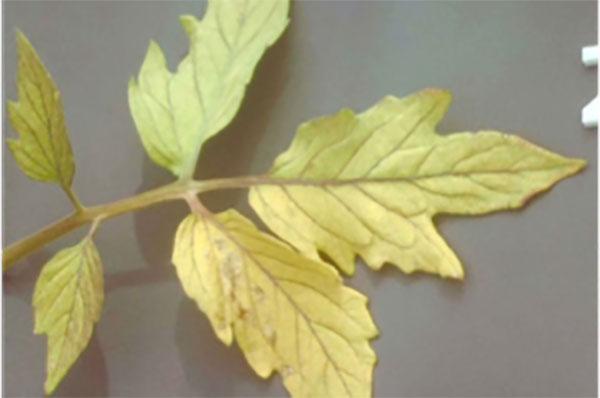
Nitrogen is the nutrient most likely to leach out of the soil. When there is a large amount of precipitation in a short time, nitrogen is flushed out of the top soil layers into deeper layers that plant roots cannot reach. Continuous small amounts of precipitation will do the same thing but slightly slower.
Symptoms include a yellowing of the lower leaves and gradually moving to the upper leaves. If the leaves have dark green veins with yellow between them, this is an iron deficiency and nitrogen supplements will not help.
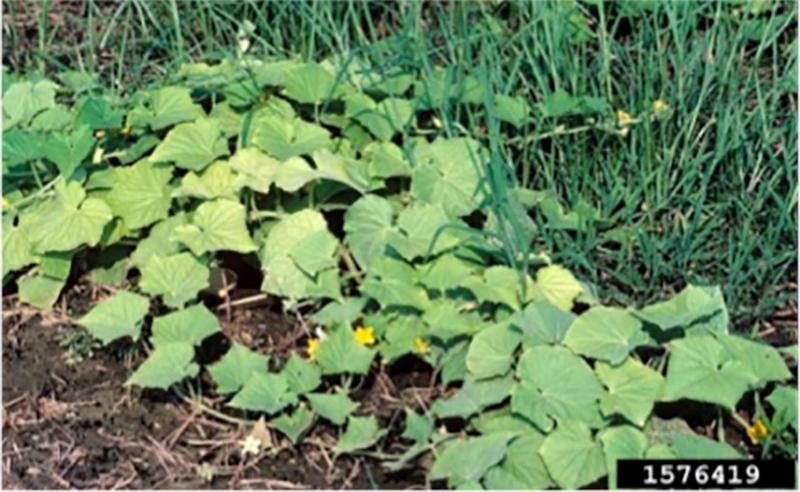
Management
To treat a nitrogen deficiency, add extra nitrogen according to package directions one time. If the weather continues to be rainy and the soil saturated, a second application may be needed a month later. Avoid over use of nitrogen as this will cause excessive green growth and reduced fruit set.
Verticillium Wilt
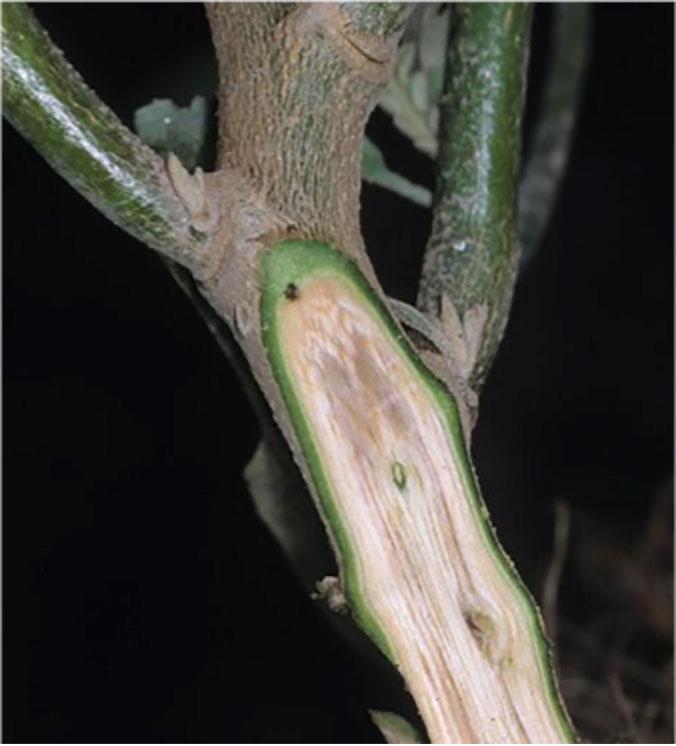
Of all the tomato diseases, verticillium wilt ranks with fusarium wilt as one of the two most feared problems. Verticillium, Verticillium albo-atrum, requires cool weather and soil that is saturated for 24 hours to germinate and grow. This spring has had ideal conditions for the spread of verticillium.
While infection can happen early, symptoms are normally seen later in the season. Plants will start to wilt from the top down and watering will not perk them up, lower leaves will yellow; mimicking nitrogen deficiency, and the inside of the stem is discolored.
To diagnose the plant, cut a large low branch off and look for chocolate brown discoloration in the vascular tissue. This discoloration is a clogging of the vascular system, specifically the xylem tissue which pulls water from the soil and moves it into the plant tissues. Eventually the xylem becomes so clogged it can no longer carry water.
Management
There is no cure for verticillium wilt. The spores are able to survive in soil for 4-10 years, making plant rotation very important. If your plants are diagnosed with verticillium wilt, pull them out and either put them in the trash or burn them. Do not compost diseased plants.
Over 300 plants can harbor verticillium wilt. This website from the Missouri Botanical Gardens has several lists of susceptible plants.
Septoria Leaf Spot

An airborne fungus, Septoria leaf spot, Septoria lycopersici, is most active in wet years when the temperatures are between 59° F and 80° F. The spores need a film of moisture on leaves to germinate. Frequent rain, high humidity and watering late in the day all provide the needed moisture.
The infection first shows up as brown spots ringed by yellow, on the lower leaves. As it progresses the spots will join into larger spots and stem develops lesions.
Management
Control is best done by watering in the morning so plants dry out before dark and using drip hoses or watering just the base of the plant will prevent foliage from getting wet. While this is not a soil borne fungus, spores do fall to the ground. Mulch will prevent any spores on the ground splashing up onto the plants.
If plants are frequently infected begin spraying a fungicide two weeks before you normally see the infection, and continue spraying weekly through the growing season. Copper soap is an organically approved fungicide providing good control. Plants with a heavy infestation should be removed and put in the trash.
Powdery Mildew
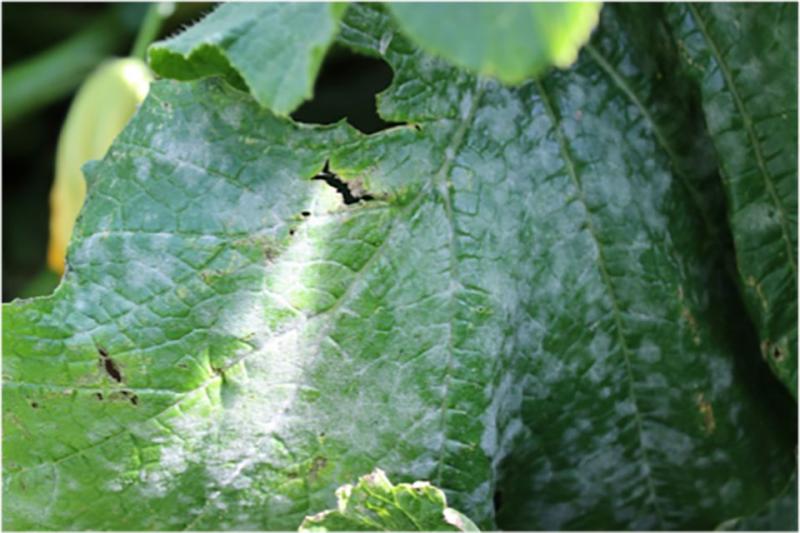
Powdery mildew, (multiple species), looks like it sounds, a white powdery coating on leaves. Like septoria and verticillium, powdery mildew spores germinate in wet conditions. The initial infection looks like a slightly whitish/yellowing area on leaves. White spores develop on the undersides of leaves first and then move to the upper side. Plants that are too close together have reduced air flow which enhances the spread of the mildew. Spores blow on the wind and will infect nearby plants.
Management
Control measures include using a fungicide as soon as the first symptoms are present. Do not wait because this fungus spreads very rapidly and is capable of covering a plant in one week. Copper and sulfur based fungicides work well. If a chemical fungicide is used, check the label to be sure that powdery mildew is one of the fungi controlled. Water plants only in the morning so leaves dry off, thin crowded plants and remove infected leaves, throwing them away. Also look for varieties that list resistance to powdery mildew.
Stem, Root and Seed Rot
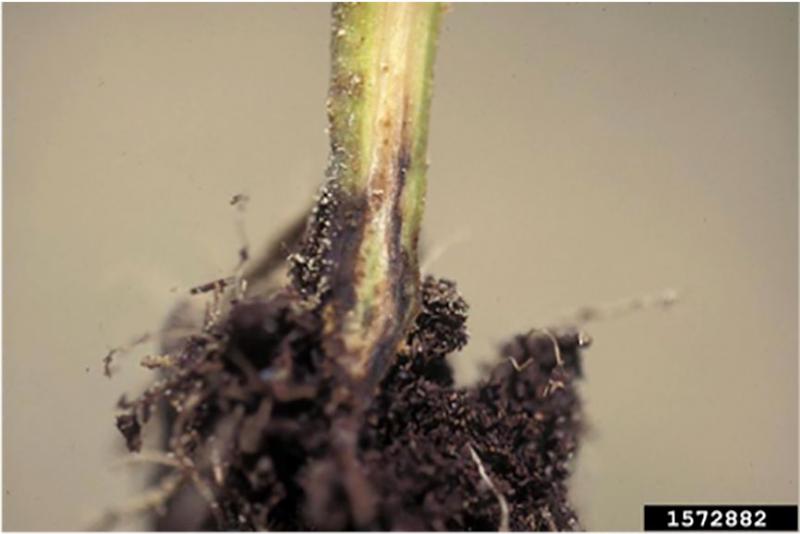
Cool wet soils cause a number of stem and root rots. Roots need to breathe oxygen and will drown just like humans. Soil that stays wet and does not drain has all the air spaces filled with water. Adding organic matter to soil, especially clay soils will loosen it and allow water to drain. Seeds planted deeply like corn, beans, peas and cucurbits will rot if the soil is saturated for more than a day or two.
Phytopthera fungi will attack seedling stems at the ground level, entering the plant in areas where there is environmental or insect damage. Stems will turn dark in color, become thin and stringy and the plant top tips over. Roots will become soft and mushy.
Management
Drenching the soil with fungicide is not a cost effective method to control soil borne fungi in large areas and will also kill the beneficial fungi in the soil necessary for plant health. If cool wet conditions are anticipated, seeds treated with a fungicide can be planted. Be sure to wear gloves and wash your hands after handling the seeds.
The best way to control stem, root and seed rot is to plant in an area with good drainage and no low areas that puddle. If good drainage is not possible, then using raised beds or containers will elevate the growing surface, allow for faster drainage and soil warming, and reduce the chances of fungal infections.
While we can’t stop all fungal infections and nutrient deficiency problems in cool wet weather, careful planning and monitoring of the garden will help to reduce them.


